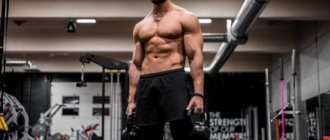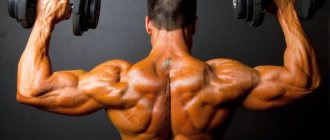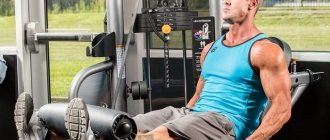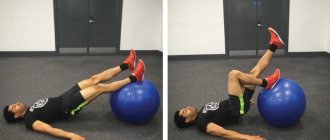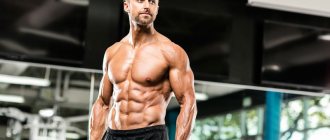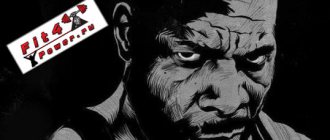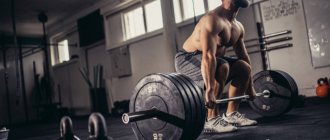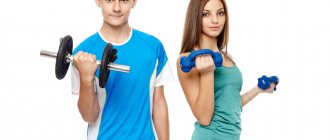Leg day is hated by many men, but skipping it is not recommended so as not to cause disharmony in body development. In addition, strong legs are the key to the body’s endurance, because your ability in running, crossfit and functional training depends on the development of the muscles of the thighs and legs. You may have heard about a set of 5 exercises to develop leg muscle strength that you can do even at home. But if you want to achieve excellent results in the shortest possible time, then sign up for training at the Multisport club. With us you will be able to train under the supervision of qualified instructors who know everything about effective training.
How to pump up your legs
If you're working your entire body in one workout, include one exercise for each muscle group.
If you prefer splits, choose one or two options for each group and add them to your leg day program. Multi-joint exercises in which the leg bends at both the hip and knee joints (squats, deadlifts, lunges) are best performed at the beginning of the workout. This way you will be able to give it your all and take on more weight than if you had first tired your muscles and nervous system with simpler loads. Perform single-joint exercises at the end of your workout.
For maximum muscle growth, do 3-5 sets of 8-12 reps. Choose the weight so that the last movements of each approach are difficult. You can do the last approach until the muscles fail.
Performing exercises with a working weight should be preceded by several warm-up approaches with a lighter barbell. For example, before squatting with a barbell of 80 kg, you can do three approaches in increments of 20 kg: 5 times with a barbell of 20 kg, 5 times with a barbell of 40 kg, 3 times with a barbell of 60 kg.
To avoid stagnation in your training, alternate exercises periodically, and also change the position of your legs and feet where possible.
We will tell you step by step how to pump up the front, back and inner thighs.
General instructions
On the days of working with hardware, fighters definitely need technical work for speed (strikes, jumps), which is advisable to do immediately after strength training - on days free from hardware, carry out standard training, but try to do less work on general physical training, in order not to overtrain, “explosive work” should not be carried out for more than six weeks, it will not increase the speed and power of strikes. — repeated use of the program for explosive strength is possible after 4-5 months.
Don't forget that we train in this program a maximum of three times a week. Monitor your health carefully. This program should be used by athletes at least at an average level of fitness, who must justify this position by skillfully regulating workloads. If, for example, you feel that after training on Monday you do not have time to recover by Wednesday, do the same complex, but not in an explosive manner, but in the usual, traditional manner of performing your repetitions. This will allow you to recover by Friday so you can have a great explosive workout that day.
Don't be afraid to vary your programs slightly depending on how you feel and your recovery. The main thing here is not to replace the feeling of incomplete recovery with ordinary, run-of-the-mill laziness, and not to look for excuses for skipping workouts or not doing particularly difficult exercises. Remember that the exercises you hate doing the most are actually the ones you need the most. Unfortunately, there is such a psychological inverse relationship.
If you are not confident enough in the correct technique of any exercise, then do not strive to immediately work on it with full load. This is especially true for exercises performed in a new, explosive mode.
If you don't hit the full load level from the first session, it won't set you back the way a muscle or tendon injury could if done incorrectly. Try to think while performing each repetition, try to mentally repeat the entire picture of the movement of the projectile and the work of your muscles. Such visualization is very valuable as a means of reinforcing the correct movement technique and forming stable neuromuscular connections. Take your time—there are no shortcuts in strength training, and the smoother your progress, the more sustainable your gains in strength and muscle size will be.
Last comment. Those fighters who worked on similar programs noted an increase in their ability to perform a higher jump, more powerful work with their arms and legs in attacking situations. One of the boxers, whom I asked to describe his feelings after 1.5 months of working on the simplest, first program, literally said the following: “Yes, sparring partners just started running from me in the ring after I got them a couple of times.”
I have no right to expect a higher assessment of my methodological work. I wish you the same success.
| The permanent address of this article on the Internet is: |
What exercises to do for the front of the thigh
Here are the quadriceps, the large muscles of four heads. The quadriceps extends the lower leg, and its central head, the rectus femoris, also flexes the thigh.
Back Squats
The exercise uses the muscles of the legs and core, and puts a good load on the front of the thigh.
Take the barbell from the racks, squeeze your shoulder blades together, straighten your chest, straighten your back. Place your feet shoulder-width apart and turn your toes slightly to the sides. Move your pelvis back and squat until your thighs are parallel to the floor. During this process, do not lift your heels off the floor and do not lie with your stomach on your knees.
As you come out of the squat, don't bring your knees together. Look straight ahead and concentrate on working your muscles.
Front Squats
Effectively pumps up A biomechanical comparison of back and front squats in trained healthy individuals the front side of the thigh, especially the inner Kinematic and EMG activities during front and back squat variations in maximum loads part (medial head). Such squats are safer for the knees and lower back than the version with weight on the back.
Remove the bar from the racks, bring your elbows forward, arch your back. Place your feet shoulder-width apart and turn your toes slightly to the sides. Squat until your thighs are parallel to the floor or slightly lower and rise back up.
Lunges
Well loaded HAMSTRINGS, QUADRICEPS, AND GLUTEAL MUSCLE ACTIVATION DURING RESISTANCE TRAINING EXERCISES, Muscle activity during leg strengthening exercise using free weights and elastic resistance: Effects of ballistic vs controlled contractions the entire front surface of the thigh.
If you have trouble keeping your balance in this exercise, try back lunges: they are easier, but less effective. Comparative Analysis of Lunge Techniques: Forward, Reverse, Walking Lunge.
You can do lunges with different weights: with a barbell on your shoulders, with dumbbells in your hands, with an expander band. To begin with, it is better to try dumbbells: it will be easier to maintain balance.
Stand up straight, take weights in your hands, straighten your shoulders, straighten your back. Lunge forward, do not touch the floor with the knee of your back leg: leave a space of 5-10 centimeters between them. Straighten up and repeat on the other leg.
Some people do lunges while walking around the gym. If your goal is to burn more calories and strengthen your core muscles, they can be helpful. But they pump up the hips worse than lunges forward in place.
Leg press in the gym
Same as squats, but with minimal stress on the core muscles and back extensors. Due to this, you can take more weight without risking breaking your back, and better load your hips. In addition, the leg press pumps up the front of the thigh just as effectively Quadriceps EMG/force relationship in knee extension and leg press as the leg extension in the simulator, but does not load the knees as much.
Sit on the exercise chair, press your lower back to the back and do not lift it until the end of the exercise. Place your feet at the bottom of the platform: this position maximizes the load on the front of the thigh. High stance of the legs provides more load on the buttocks.
Under the weight of the platform, bend your legs to a right angle at the knees, and then press it back. At the extreme point, do not straighten your knees completely, leave them slightly bent.
What exercises to do for the back of the thigh
The biceps femoris, semimembranosus and semitendinosus muscles are located here. They extend the thigh and flex the lower leg.
Deadlift
Pumps HAMSTRINGS, QUADRICEPS, AND GLUTEAL MUSCLE ACTIVATION DURING RESISTANCE TRAINING EXERCISES, Muscle activation during lower body resistance training the entire back surface of the body: back extensors, buttocks, hamstrings and calves.
Walk up to the barbell and stand so that the bar is positioned above the laces of your sneakers. Place your feet shoulder-width apart and turn your toes slightly to the sides. Move your pelvis back, bend over with a straight back and grab the bar so that your palms are shoulder-width apart.
Keeping your back straight, straighten your body and stand straight with the barbell in your hands. Bring the bar very close to your shins, then the bar will follow an ideal trajectory. After straightening, lower the apparatus to the floor and repeat the exercise.
The back of the thigh is pumped approximately equally in any type of deadlift. By changing the execution, you can increase the load on other muscles:
- Stiff-legged deadlifts better develop Electromyographic Activity of Lower Body Muscles during the Deadlift and Stiff-Legged Deadlift calf muscles.
- The sumo deadlift better loads An electromyographic analysis of sumo and conventional style deadlifts on the front of the thigh: the lateral and medial heads and the front of the lower leg.
Hull lifts on GHD
Good for muscle activation during various hamstring exercises, Kettlebell swing targets semitendinosus and supine leg curl targets biceps femoris: An EMG study with rehabilitation implications of the hamstrings, as well as the buttocks and back extensors.
Place your feet under the rollers of the machine, extend your body parallel to the floor, and place your hands behind your head. Lower your body, keeping your back straight, and then rise until it is parallel to the floor or slightly higher.
To make the exercise more challenging, add free weights. If you need weighting up to 5 kg, take a weight plate and hold it next to your head; if more, place a bodybar, barbell or barbell on your shoulders.
Good morning
Good loads Muscle activation during various hamstring exercises and stretches the back of the thigh, pumps up the back extensors.
Place your feet shoulder-width apart, pointing your toes forward. Place the barbell on your shoulders, straighten and slightly arch your back. Bend your knees slightly, move your pelvis back and tilt your body forward until it is parallel to the floor. Straighten up and repeat.
Here it is important to move your pelvis back and keep your back straight. If you don't have enough stretch to do this exercise correctly, replace it with another one.
Bulgarian split squat
Split squat pumps up the hamstrings better. Comparison of lower extremity EMG between the 2-leg squat and modified single-leg squat in female athletes, Hip-Muscle Activation During the Lunge, Single-Leg Squat, and Step-Up-and-Over Exercises , Muscle Activity in Single- vs. Double-Leg Squats than regular squats, lunges and step-ups.
Stand with your back one step away from a small elevation, such as a bench. Place one sock on a raised platform and squat down until your thighs are parallel to the floor. Straighten up and repeat.
First try a split squat without weights. If you can maintain your balance, you can take dumbbells or squat with a barbell on your shoulders.
Bend forward on your knees
Perfectly loads Muscle activation during lower body resistance training, Kettlebell swing targets semitendinosus and supine leg curl targets biceps femoris: An EMG study with rehabilitation implications of the posterior thigh. If possible, do it with a partner; if not, try putting your feet under a machine or rack. Just don't forget to place a rug under your knees.
Fix your legs, stretch your body and hips in one line. Lean forward as much as possible. But only as much as it is possible to maintain a straight body position and not bend at the hip joints. Get back up and repeat.
Rules and principles for developing physical strength
An athlete who works on his body must understand the main thing:
- Growth (working hypertrophy) of muscle tissue is a mandatory side effect of anaerobic training. If you are afraid of becoming stronger and more athletic, you should not get involved in weight training.
- The amount of creatine phosphate in tissues needs to be increased (the more of this substance in the muscles, the better the strength endurance of a woman or man). Many people drink creatine in the form of a dietary supplement, but a safer option is to obtain creatine phosphoric acid with food (meat, seafood, milk, etc.).
- In parallel with strength, you need to develop intermuscular coordination. The more coordinated the muscles function, the less force is expended during training (the body uses only those parts of the musculoskeletal system that are necessary to perform a specific action).
- With the comprehensive development of strength, it is necessary to work on the conductivity (innervation) of muscle fibers. The connection between muscles and the central nervous system must be carried out quickly and accurately. You can speed up the communication between the brain and muscles through regular physical activity with constantly increasing intensity.
In addition, it should be remembered that anaerobic training can lead to injury. Our guide will help you avoid sprains and tears in your ligaments.
Exercise naturally
. The body takes a long time to get used to new ways of working, so at first it is better to do exercises that are as similar as possible to everyday movements - squats, standing weight presses.
Avoid training through pain
. Severe discomfort occurs in cases where a person overloads the body. This defensive reaction may indicate that the muscle fibers are already too stretched or even torn.
Flex different muscles
. Isolation strength training is difficult even for professional bodybuilders. Normally, an athlete should do a variety of physical exercises for a large muscle group (muscles of the back, legs, etc.) during each workout.
Increase weights gradually
. It is recommended to start with exercises with weights in the form of your own body weight, and after months of training, lifting light dumbbells and weights is allowed.
Do not increase your exercise time too dramatically
. In sports there is a concept of overtraining. The condition of a person who has performed anaerobic exercise for too long is similar to the state of health of a person who has suffered from a debilitating illness. Normally, women start with short 10-minute workouts, and men with 15-minute workouts.
Practice at your own pace
. Professionals quickly perform French presses and other strength exercises that require precise movements. They succeed in this due to the fact that the actions have already been brought to automaticity. For beginners, it’s better to take your time so as not to overwork your muscles.
Use comfortable sportswear and professional equipment
. The use of exercise machines significantly reduces the risk of injury. Developing physical strength in a fitness center or at home under the supervision of a trainer is considered even safer. However, you can also exercise on your own at home without risk to your health - just buy a comfortable tracksuit and high-quality dumbbells.
Control every move
. You need to monitor the sensations that arise in the muscles when performing certain exercises. Try to remember which muscles tense more and which muscles tense less. Over time, you will be able to use more muscles even with standard loads.
What exercises to do for the inner thigh
Here are located the thin, long, short and magnus adductor muscles, as well as the pectineus muscle. They all adduct the hip and participate in its flexion.
Adduction of legs
EMG evaluation of hip adduction exercises for soccer players: implications for exercise selection in prevention and treatment of groin injuries can be performed using a crossover or resistance band hooked to a stand.
Place the crossover mount on your right ankle and stand one step away from the lower block with your right side facing it. Raise your leg slightly to the side. Overcoming the resistance of the crossover, bring your right leg towards your left, take it back and repeat. When you finish the set, perform on the other leg. Now the mount will be on your left leg and you will stand with your left side to the block.
If performing with a resistance band, hook the band to the stand at shin level and place the loose loop around your ankle. Otherwise, the movement is the same as in the crossover.
Copenhagen ghosts
This exerciseEMG evaluation of hip adduction exercises for soccer players: implications for exercise selection in prevention and treatment of groin injuries can be performed with a partner, on loops, a bar, or a bench. Get into a side plank position on your elbow with your top ankle elevated or tucked into a loop. Or ask your partner to hold your thigh and ankle.
Bring your lower leg towards your upper leg and lower it back down. If you do it on a bar, in loops or with a partner, you can do it straight; if you do it on a bench or box, you can do it with the knee bent.
Information on the simulator
Simple and effectiveEMG evaluation of hip adduction exercises for soccer players: implications for exercise selection in prevention and treatment of groin injuries option for indoor training. Sit on the exercise machine, press your lower back to the chair, grab the handles. Bring your legs together and spread them back.
What exercises to do for the lower leg muscles
The shape of the lower leg is determined by the gastrocnemius and soleus muscles. To load the Isolated Gastrocnemius Tightness calf muscle, you need to extend your feet with straight knees, but the soleus is better activated when your knees are bent at a right angle.
In addition, speed matters: the gastrocnemius reacts better to fast movements, the soleus - to slow ones.
Single leg calf raises
The exercise is greatElectromyographic Analysis of the Triceps Surae Muscle Complex During Achilles Tendon Rehabilitation Program Exercises targets the calf muscles.
Stand with your toes on the plate, lift one leg. Get up on your toes and lower back down. Gradually increase the range, dropping your heel a little lower. If you have good balance, you can pick up dumbbells.
Standing calf raises
ExerciseElectromyographic Analysis of the Triceps Surae Muscle Complex During Achilles Tendon Rehabilitation Program Exercises on the calf muscle. You can perform it in a special machine or simply with a barbell on your shoulders. Quickly rise up onto your toes and lower back down.
Seated calf raises
This variation works well on the Isolated Gastrocnemius Tightness muscles, so perform the lifts slowly. You can do the exercise in a machine or with a barbell on your knees.
If you choose the barbell option, place a weight plate under your socks to increase the range of motion and stretch the muscles at the bottom. Also, place a cushion on the bar, otherwise it will dig into your legs.
Explosive strength and methods of training it
To understand why you need to train explosive strength, let’s look at this concept itself. Explosive (or speed) strength is a colossal release of energy to a specific muscle group for a short period of time. In theory it sounds a little vague and vague, but in practice everything is very simple. Imagine a boxing match when one of the fighters, waiting for the right moment, knocks out his opponent with a lightning-fast blow. This happens so quickly that spectators often do not even have time to follow the athlete’s movement. This is the phenomenon of speed force.
Explosive strength is necessary primarily for representatives of contact sports (boxers, wrestlers, judokas and many others) to train reaction and striking power. For runners, skiers and skaters, such activities are necessary for a quick start. Representatives of team sports train speed strength to perform rapid passes and powerful throws.
Weightlifters and powerlifters also need to develop explosive strength in order to successfully lift large weights in the bench press and jerk. And even for bodybuilders who build muscle volume rather than strength, such training will be useful. In particular, it helps to break out of a training plateau. To overcome this unpleasant process for every athlete and achieve an increase in muscle mass, you can use the Leveton Forte dietary supplement, which contains drone brood, as well as Leuzea root and bee pollen, known for their adaptogenic and anabolic properties.
In addition, training in this style can stimulate the growth of transverse muscles, which are often difficult to pump up during regular exercise.
